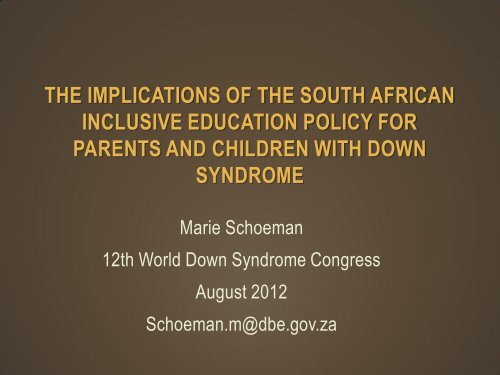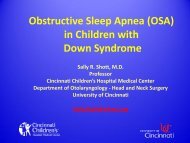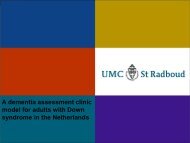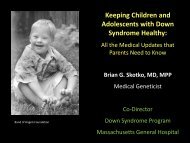the implications of the south african inclusive education policy for ...
the implications of the south african inclusive education policy for ...
the implications of the south african inclusive education policy for ...
You also want an ePaper? Increase the reach of your titles
YUMPU automatically turns print PDFs into web optimized ePapers that Google loves.
THE IMPLICATIONS OF THE SOUTH AFRICANINCLUSIVE EDUCATION POLICY FORPARENTS AND CHILDREN WITH DOWNSYNDROMEMarie Schoeman12th World Down Syndrome CongressAugust 2012Schoeman.m@dbe.gov.za
ABSTRACT• Since <strong>the</strong> passing <strong>of</strong> <strong>the</strong> Policy on Inclusive Education in South Africa in 2001, <strong>the</strong>Department <strong>of</strong> Basic Education has introduced numerous strategic steps to change<strong>the</strong> system so that all children can attend <strong>the</strong>ir local neigbourhood schools and besupported by teachers to access <strong>the</strong> curriculum.• Key <strong>policy</strong> implementation guidelines such as <strong>the</strong> Guidelines <strong>for</strong> Inclusive Schoolsand <strong>the</strong> Strategy on Screening, Identification, Assessment and Support as well as<strong>the</strong> National Curriculum Statement and Assessment Protocol, make it possible <strong>for</strong>children with Down Syndrome to attend an ordinary class in <strong>the</strong>ir local school.Parents, however play a central role in <strong>the</strong> support <strong>of</strong> <strong>the</strong>ir children and working inpartnership with teachers.• Changing <strong>of</strong> parents’ and communities’ perspectives on disability is one <strong>of</strong> <strong>the</strong> keychallenges in <strong>the</strong> implementation <strong>of</strong> <strong>the</strong> <strong>policy</strong>. Teacher training is ano<strong>the</strong>r criticalcomponent that needs to be addressed. The paper challenges <strong>the</strong> notion thatimplementation <strong>of</strong> <strong>the</strong> <strong>policy</strong> cannot happen be<strong>for</strong>e <strong>the</strong> whole system has beenprepared <strong>for</strong> it. All children already have an intrinsic right to participate and besupported in terms <strong>of</strong> <strong>the</strong> Convention on <strong>the</strong> Rights <strong>of</strong> Persons with Disabilities.
WHAT PARENTS FEEL• “Really <strong>the</strong> child is not progressing at that school, even <strong>the</strong>doctors confirmed that he cannot be taught at such schoolshe needs special kind <strong>of</strong> <strong>education</strong>. This will enable him tolearn at his own pace and to get teachers who are trainedto train and take care <strong>of</strong> children like him.”• “I don’t think she will have a good life, because she is not inschool, maybe if we could af<strong>for</strong>d those schools where <strong>the</strong>yteach people like her, but I hear <strong>the</strong>y are far and expensive”Extracts <strong>of</strong> interviews conducted with parents in a ruralprovince <strong>of</strong> South Africa by T. Thejane. (1999).3
“The lives <strong>of</strong> many people with disabilities are restrictedand diminished more by <strong>the</strong> negative attitudes, beliefs andprejudice <strong>of</strong> <strong>the</strong>ir neighbours and local communitythan by <strong>the</strong>ir own limitations (Buckley, Bird : 1992).4
ONE RURAL ORDINARY SCHOOLMokgalabye School inVhembe, Limpopo,Fully accessible and<strong>inclusive</strong>5
ATTENDING THE LOCAL NEIGHBOURHOODSCHOOL.
WHAT IS PREVENTING PARENTS TO ADMITTHEIR CHILDREN TO AN ORDINARY SCHOOL?• Attitudes <strong>of</strong> <strong>the</strong> community• Advice by pr<strong>of</strong>essionals• Assumptions about special schools• Transport challenges• Lack <strong>of</strong> trust in teachers’ willingness to be accommodating andsupportive• Lack <strong>of</strong> in<strong>for</strong>mation on Education Policy• Lack <strong>of</strong> empowerment7
WHAT IS REQUIRED TO ENSURE QUALITYEDUCATION AND SUPPORT FOR ALL IN ANINCLUSIVE EDUCATION SYSTEM?• Laws – <strong>policy</strong> framework• Advocacy – parents and supporters• Educational innovation – in school and classroompractices(Porter, Smith et al. 2011)8
LEGAL AND POLICY FRAMEWORK• Constitutional imperatives:• Dignity, freedom <strong>of</strong> choice, non-discrimination, linguistic identity, access to basic<strong>education</strong> and incrementally to FET• Education White Paper 6:• Qualitative improvement <strong>of</strong> special schools• Phased conversion <strong>of</strong> special schools into resource centres• Social rights approach to special needs <strong>education</strong>• Promoting access to local neighbourhood schools• Central role to be played by parents / caregivers• South African Schools Act:• One system making provision <strong>for</strong> both public ordinary and special schools,reasonable accommodation and support in mainstream• Adhere to financial regulations, Governance structures• National Curriculum Statement Gr R – 12 and <strong>the</strong> Curriculum andAssessment Policy Statements (CAPS):• One curriculum <strong>for</strong> all – effective differentiation and support ensuring thateveryone can obtain meaningful qualifications
‘Education and training are basic human rights. The state has an obligationto protect and advance <strong>the</strong>se rights, so that all citizens irrespective <strong>of</strong> race,class, gender, creed or age, have <strong>the</strong> opportunity to develop <strong>the</strong>ir capacitiesand potential, and make <strong>the</strong>ir full contribution to society.’(White Paper on Education and Training, March 1995:21)Section 5(1) A public school must admit learners and serve <strong>the</strong>ir <strong>education</strong>alrequirements without unfairly discriminating in any way.Section 12(4) The Member <strong>of</strong> <strong>the</strong> Executive Council must, where reasonably practicable,provide <strong>education</strong> <strong>for</strong> learners with special <strong>education</strong> needs at ordinarypublic schools and provide relevant <strong>education</strong>al support services <strong>for</strong> suchlearners.(5) The Member <strong>of</strong> <strong>the</strong> Executive Council must take all reasonable measures toensure that <strong>the</strong> physical facilities at public schools are accessible to disabledpersons.(South African Schools Act, 1996)
CONVENTION ON THE RIGHTS OF PERSONSWITH DISABILITIES 2007Article 24 - EducationThis article recognizes <strong>the</strong> right <strong>of</strong> persons with disabilities to<strong>education</strong> on <strong>the</strong> basis <strong>of</strong> equal opportunity, ensuring an<strong>inclusive</strong> <strong>education</strong> system at all levels and <strong>the</strong> facilitation <strong>of</strong>access to lifelong learning.Respect dignity <strong>of</strong> all learners and <strong>the</strong> right to develop <strong>the</strong>irfull potentialEqual access to <strong>inclusive</strong> schools in <strong>the</strong> communities in which<strong>the</strong>y livereasonable accommodation must be made <strong>for</strong> persons withdisabilities
IDEALS OF INCLUSIONWhite Paper 6 proposed all <strong>the</strong> key approaches <strong>of</strong> <strong>the</strong>inclusion movement:• School-wide approaches, belief that all children canlearn• Sense <strong>of</strong> community• Services based on need ra<strong>the</strong>r than location• Natural proportion• Support provided in general <strong>education</strong>• Teacher collaboration• Curriculum adaptations• Enhanced instructional strategies• Concern <strong>for</strong> standards and outcomesLipsky and Gartner, 1999
WHO IS TARGETED BY INCLUSIVE EDUCATION?Broad vision <strong>of</strong> inclusion seeks to remove barriers that preventlearners to benefit from <strong>education</strong> and achieve <strong>the</strong>ir full potential.Three groups <strong>of</strong> learners targeted:1. Learners in mainstream schools that are failing to learn due to barriers<strong>of</strong> whatever nature (family disruption, language issues, poverty,inappropriate teaching).2. Learners in special schools who have been placed in <strong>the</strong> school on <strong>the</strong>basis <strong>of</strong> <strong>the</strong>ir disability (disability is considered to be a barrier, although<strong>the</strong>re may be many o<strong>the</strong>r barriers in addition).3. Learners <strong>of</strong> compulsory school-going age who are out <strong>of</strong> school or whohave never been enrolled in school due to barriers <strong>of</strong> whatever nature(multiple disabilities and poverty are two <strong>of</strong> <strong>the</strong> major barriers <strong>for</strong> thisgroup).
REALITIES IN SPECIAL EDUCATION PROVISION• Special schools increased from 375 in 2002 to 423 in 2011enrolment from 77 700 to 104 633• More than 120 000 Children with disabilities in <strong>the</strong> mainstream• Estimated 400 000 Children with disabilities out <strong>of</strong> school• Unequal distribution <strong>of</strong> schools – mainly in urban centres• Neglect in some special schools in rural areas• Curriculum delivery not always up to standard• Teachers have little specialised training• Lack <strong>of</strong> assistive technology or inappropriate use and management• Inadequate transport• Incidents <strong>of</strong> abuse
POLICY ON SCREENING,IDENTIFICATION, ASSESSMENT ANDSUPPORTWHAT THIS MEANS FOR PARENTS15
ROLE OF PARENTS AS ADVOCATES AND PARTNERS 1• Acknowledging <strong>the</strong> pivotal role <strong>of</strong> parents/care givers is key factor in<strong>the</strong> early identification <strong>of</strong> barriers.• Parents’/care givers’ observations and comments can lead <strong>the</strong>educator to find <strong>the</strong> exact nature <strong>of</strong> <strong>the</strong> barriers that a learnerexperiences.• Parents/care givers should at all times be involved in <strong>the</strong> identificationand assessment processes involving <strong>the</strong>ir child, and should beregarded as equal partners in this process.• Parents/care givers should also be free to initiate contact wi<strong>the</strong>ducators regarding <strong>the</strong>ir child’s progress.• When choices have to be made about <strong>the</strong> learner’s enrolment into asite where additional support is available, parents/care givers need tohave full in<strong>for</strong>mation about all options so that <strong>the</strong>y can make in<strong>for</strong>medchoices.
ROLE OF PARENTS AS ADVOCATES AND PARTNERS 2• The unwillingness or inability <strong>of</strong> <strong>the</strong> system tosupport <strong>the</strong> learner in <strong>the</strong> current site should neverbe a primary motivation to move a learner,especially if it is necessary <strong>for</strong> <strong>the</strong> child to attendschool far from home.• The financial situation <strong>of</strong> <strong>the</strong> family and <strong>the</strong>ircapacity to pay (especially in terms <strong>of</strong> transport) <strong>for</strong><strong>the</strong> choice <strong>of</strong> school should be taken into account.17
RESPONSIBILITY OF PARENTS• Parents need to take responsibility <strong>for</strong> <strong>the</strong> support <strong>of</strong> <strong>the</strong>irchildren in <strong>the</strong> most <strong>inclusive</strong> setting possible.• Parents should be empowered to understand how <strong>the</strong>potential <strong>of</strong> <strong>the</strong>ir child can be optimally developed.• They need access to in<strong>for</strong>mation on <strong>the</strong> kinds <strong>of</strong> supportneeded by <strong>the</strong>ir child.• They must know <strong>the</strong>ir rights in terms <strong>of</strong> accessing availablesupport.• Parents must make every ef<strong>for</strong>t to ensure that <strong>the</strong>ir childhas access to an appropriate early intervention programmewhich is available in <strong>the</strong>ir area.18
RESPONSIBILITY OF PARENTS• Parents/caregivers who suspect that <strong>the</strong>ir child hasadditional support needs, but has not accessed earlyintervention programmes prior to <strong>the</strong> child turning 3 yearsold, must report to <strong>the</strong> local ordinary school as early aspossible but no later than <strong>the</strong> age <strong>of</strong> 5 years.• The local school must complete <strong>the</strong> relevant <strong>for</strong>ms inconsultation with <strong>the</strong> parent/caregiver.• Parents/caregivers must play a meaningful role in <strong>for</strong>ming apartnership with <strong>the</strong> educator to ensure that <strong>the</strong> supportoutlined in <strong>the</strong> Individual Support Action Plan is successfullyimplemented.• Parent/caregiver participation in <strong>the</strong> SIAS process is not amatter <strong>of</strong> choice, but compulsory19
GUIDELINES FOR RESPONDING TODIVERSITY IN THE CLASSROOMWHAT PARENTS NEED TO KNOW20
RESPONDING TO DIVERSITY – SOMEIMPERATIVES FOR TEACHERS• Recognising bias and or stereotypes against certain learners• Treating and respecting each learner as an individual• Avoiding use <strong>of</strong> biased language that undermines certain groups• Refraining from making assumptions about learner experiences• Considering unique needs <strong>of</strong> learners during lesson / programmedesign• Constantly re-evaluating methods <strong>of</strong> teaching and assessing• Always varying approaches, methodologies and strategies• Creating opportunities <strong>for</strong> all learners to participate in <strong>the</strong> learningprocess
CURRICULUM DIFFERENTIATION• A key strategy <strong>for</strong> responding to diversity• Takes into account differences in learners’ ability levels,interests, background etc.• Modification, changing, adapting, extending and varyingaspects <strong>of</strong> <strong>the</strong> curriculum• Aspects <strong>of</strong> <strong>the</strong> curriculum to be Differentiated:• Content• Teaching methodologies• Learning environment• Assessment
Common Core Standards<strong>the</strong> meaning <strong>of</strong> a word or phrase.ContentAlignmentMoreRigor*CommentsNorth Dakota Content Standardsprefixes/suffixes, multiplemeaning words, context clues, andword reference aids – dictionary,glossary, <strong>the</strong>saurus, base wordsb. Use common, gradeappropriateGreek or Latin affixesand roots as clues to <strong>the</strong> meaning<strong>of</strong> a word (e.g., audience, auditory,audible).Partial (emphasisand phrasing)NDContent is similar, with somedifference in emphasis. CC content isin grade 6. ND content is in grade 5.5.2.7. Use word reference resources todetermine word meaning i.e.,dictionary, <strong>the</strong>saurus, andGreek/Latin root histories* Rigor: CC: Common Core standards are more rigorous; ND: North Dakota standards are more rigorousGrade 6 PAGE 23
DIFFERENTIATING ASSESSMENTNATIONAL PROTOCOL ON ASSESSMENT• The minimum requirements <strong>for</strong> achieving grades may not becompromised. However, within a flexible learner-based andlearner-paced approach to <strong>the</strong> curriculum, all learners could beenabled to achieve <strong>the</strong>ir full potential irrespective <strong>of</strong> whe<strong>the</strong>r or not<strong>the</strong> end result will be a final certificate.• There needs to be consistent representation <strong>of</strong> <strong>inclusive</strong>assessment practice across all grades. This needs to be dealt within assessment, recording, reporting and promotion.• Learners who experience barriers to learning in both ordinary andspecial schools need to be able to exit school with a recognition <strong>of</strong>competence.24
THREE PROPOSED TYPES OF ALTERNATEASSESSMENT (1)1. Alternate Assessments Based on AlternateAttainment <strong>of</strong> Knowledge (content, concepts andskills) <strong>for</strong> learners with a significant cognitivedisability. These assessments are based on <strong>the</strong>grade-level content covered by <strong>the</strong> generalassessment, but at reduced depth, breadth, andcomplexity. These assessments describeachievement based on what is determined as ahigh expectation <strong>for</strong> <strong>the</strong>se learners. Targetlearners can include learners with intellectualdisability who are currently enrolled in specialand ordinary schools.
ASSESSING DIVERSE LEARNERS• All three types <strong>of</strong> assessment should, wherepossible be available in ordinary and specialschools.• Every learner should be assessed.• There should be high expectations <strong>of</strong> all learners.• All learners should have <strong>the</strong> opportunity to receivea school leaving statement.26
EXIT LEVEL VOCATIONAL QUALIFICATION ATGRADE 9• Currently a national task team is working on <strong>the</strong> development <strong>of</strong>a vocational qualification and curriculum which will be availablein ordinary and special schools• 50% academic• 50% skills / vocational content• Will include practical / vocational subjects in all subject fields• Will accommodate learners across <strong>the</strong> spectrum from severeand pr<strong>of</strong>ound to moderate intellectual disability• Will ensure high expectations• Will be aligned to needs <strong>of</strong> industry27
THE ROLE OF FULL-SERVICE /INCLUSIVE SCHOOLS IN CHANGINGATTITUDES OF COMMUNITIES
WHAT IS A FULL-SERVICE/INCLUSIVE SCHOOL?With <strong>the</strong> introduction <strong>of</strong> <strong>the</strong> <strong>policy</strong> on InclusiveEducation, as published in Education White Paper 6 <strong>of</strong>2001, <strong>the</strong> Department <strong>of</strong> Education made acommitment to ensure that all children would bewelcomed in all schools and that <strong>the</strong>y would besupported to develop <strong>the</strong>ir full potential irrespective<strong>of</strong> <strong>the</strong>ir background, culture, abilities or disabilities,<strong>the</strong>ir gender or <strong>the</strong>ir race. The concept fullservice/<strong>inclusive</strong>school was introduced to show howordinary schools can trans<strong>for</strong>m <strong>the</strong>mselves to becomefully <strong>inclusive</strong>.
WHAT ARE THE KEY FEATURES OF ANINCLUSIVE SCHOOL?• They are schools that welcome all learners andcelebrate diversity;• They are flagship schools that demonstrate bestpractice in <strong>inclusive</strong> <strong>education</strong>;• They ensure that <strong>the</strong> curriculum is accessible to alllearners through <strong>the</strong> way in which <strong>the</strong>y teach andallow learners to learn;• They provide support to all learners in a multitude <strong>of</strong>creative ways without necessarily referring <strong>the</strong>melsewhere;• They promote team work amongst teachers andbetween teachers and parents;
KEY FEATURES CONT.....• They have a flourishing relationship with o<strong>the</strong>r schools andwith all members <strong>of</strong> <strong>the</strong> community and send a message <strong>of</strong>tolerance, respect and acceptance towards all;• They are advocates <strong>for</strong> all learners who are at risk <strong>of</strong>becoming marginalised, including learners with disabilities,chronic illness, learning difficulties and social, emotionaland behaviour problems;• They take every possible measure to ensure that <strong>the</strong> schoolis physically accessible, safe and equipped with <strong>the</strong>necessary equipment that individual learners might need;and• They demonstrate how all children <strong>of</strong> school-going age canattend <strong>the</strong>ir local school and achieve <strong>the</strong>ir full potential.
THE ROLE OF PRINCIPAL AND MANAGEMENT• The Principal and members <strong>of</strong> <strong>the</strong> SchoolManagement Team (SMT) play a vital role in <strong>the</strong>implementation <strong>of</strong> <strong>inclusive</strong> <strong>education</strong>.• The school management takes a lead in changing <strong>the</strong>attitudes <strong>of</strong> all stakeholders;• They establish a school-based support team whichcoordinates support to all learners in <strong>the</strong> school bymeeting regularly, giving guidance to teachers andtracking support;• They encourage active parental participation in <strong>the</strong>school and learners’ <strong>education</strong>; and• They <strong>for</strong>m networks with existing communityresources such as SGBs, caregivers, families, disabilityorganizations, health and social services, NGOs andHigher Education Institutions.
THE ROLE OF TEACHERS• They work in teams and find solutions through jointproblem solving;• They apply systems and teaching approaches that meet<strong>the</strong> needs <strong>of</strong> all children.• They are flexible in how <strong>the</strong>y implement <strong>the</strong> curriculum;• They adapt <strong>the</strong>ir classroom methodology to ensure thatall children receive attention;• They continuously improve <strong>the</strong>ir skills to teach in <strong>inclusive</strong>classrooms;• They have high expectations <strong>of</strong> all <strong>the</strong>ir learners andmeasure <strong>the</strong>m against <strong>the</strong>ir own previous bestachievements and not against <strong>the</strong>ir peers; and• They respect disability and human rights.
THE ROLE OF PARENTS• Parents know <strong>the</strong>ir rights and those <strong>of</strong> <strong>the</strong>ir children;• Parents collaborate with teachers by staying in<strong>for</strong>medand supporting <strong>the</strong>ir children with homework;• Parents foster <strong>the</strong> independence <strong>of</strong> <strong>the</strong>ir children andhave high expectations irrespective <strong>of</strong> <strong>the</strong>ir abilities ordisabilities;• Parents cannot be expected to pay <strong>for</strong> a classroomassistant to support <strong>the</strong>ir child in school.; and• Parents are assisted by <strong>the</strong> school to approach Healthservices to obtain hearing aids or wheel chairs <strong>for</strong> <strong>the</strong>irchildren.
CONCLUSION• Can parents wait until <strong>the</strong> system is ready <strong>for</strong> <strong>the</strong>ir children?• All policies are in place.• Parents must claim <strong>the</strong>ir rights and those <strong>of</strong> <strong>the</strong>ir children.• The end result will be that schools and society in general willbecome more tolerant and understanding.• "In a pluralistic society all children must grow up with o<strong>the</strong>rs whoare different. Exposure and involvement from an early age willprepare all to function peacefully and constructively. Moregenerations <strong>of</strong> adults who become "upset" and distracted when<strong>the</strong>y see a person with a disability cannot be tolerated." (Brownet. al. : 1989).37
Obtain in<strong>for</strong>mation on latest policies onInclusive Education atwww.thutong.doe.gov.za/<strong>inclusive</strong><strong>education</strong>
REFERENCES• Department <strong>of</strong> Education. (2001) White Paper 6 on Special Needs Education:Building an Inclusive Education and Training System. Pretoria, South Africa.• Department <strong>of</strong> Basic Education (2010) Guidelines <strong>for</strong> Full-Service/InclusiveSchools. Pretoria: Department <strong>of</strong> Basic Education.• Department <strong>of</strong> Basic Education (2011a) Guidelines <strong>for</strong> Responding toDiversity in <strong>the</strong> Classroom. Pretoria: Department <strong>of</strong> Basic Education.• Department <strong>of</strong> Basic Education (2011b) National Curriculum Statement, Gr R– 12. Pretoria: Department <strong>of</strong> Basic Education.• Department <strong>of</strong> Education (2007) Guidelines to ensure quality <strong>education</strong> andsupport in special schools and special school resource centres. Pretoria:Department <strong>of</strong> Education.• Department <strong>of</strong> Education (2008) National Strategy on Screening,Identification, Assessment and Support. Pretoria: Department <strong>of</strong> Education.39
• McKenzie, J., & Loebenstein, H. (2006). Increasing parental recognition andinvolvement. In P. Engelbrecht & G. L. (Eds.), Responding to <strong>the</strong> challenges <strong>of</strong><strong>inclusive</strong> <strong>education</strong> in sou<strong>the</strong>rn Africa. (pp. 186-200). Pretoria: Van SchaikPublishers.• McKenzie, J., & Muller, B. (2006). Parents and <strong>the</strong>rapists: Dilemmas inpartnership. In B. Watermeyer, L. Swartz, T. Lorenzo, M. Schneider & M.Preistley (Eds.), Disability and Social Change : A South African Agenda (pp.311-323). Cape Town: HSRC Press.• Mitchell, D. Ed. (2005) Contextualising Inclusive Education: Evaluating oldand new international perspectives. Routledge, New York, London.• Molteno, C. ( 2006). Education and intellectual disability in South Africa.[Editorial]. Journal <strong>of</strong> Child and Adolescent Mental Health, 18(2), iii.• Rieser, R (2008) Implementing Inclusive Education: A CommonwealthGuide to Implementing Article 24 <strong>of</strong> <strong>the</strong> UN Convention on <strong>the</strong> Rights <strong>of</strong>People with Disabilities. Commonwealth Secretariat, London.40












